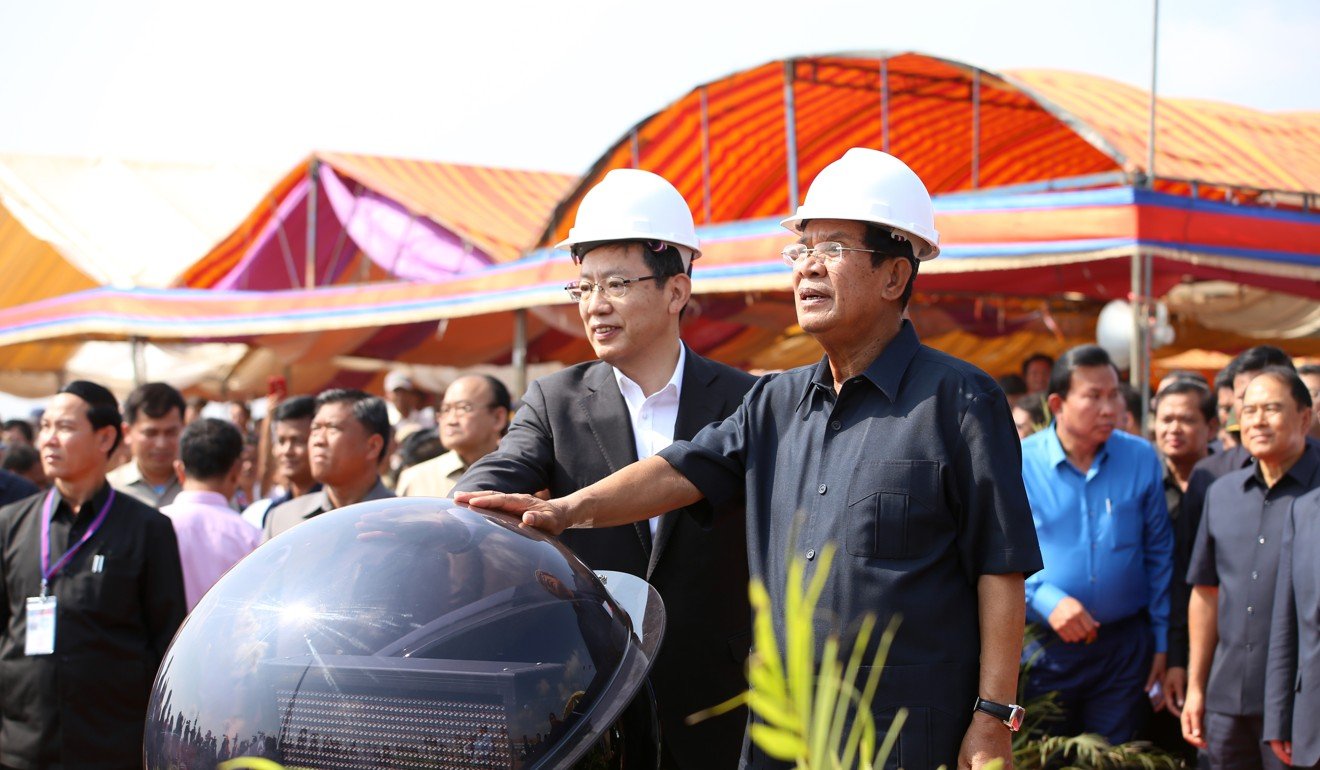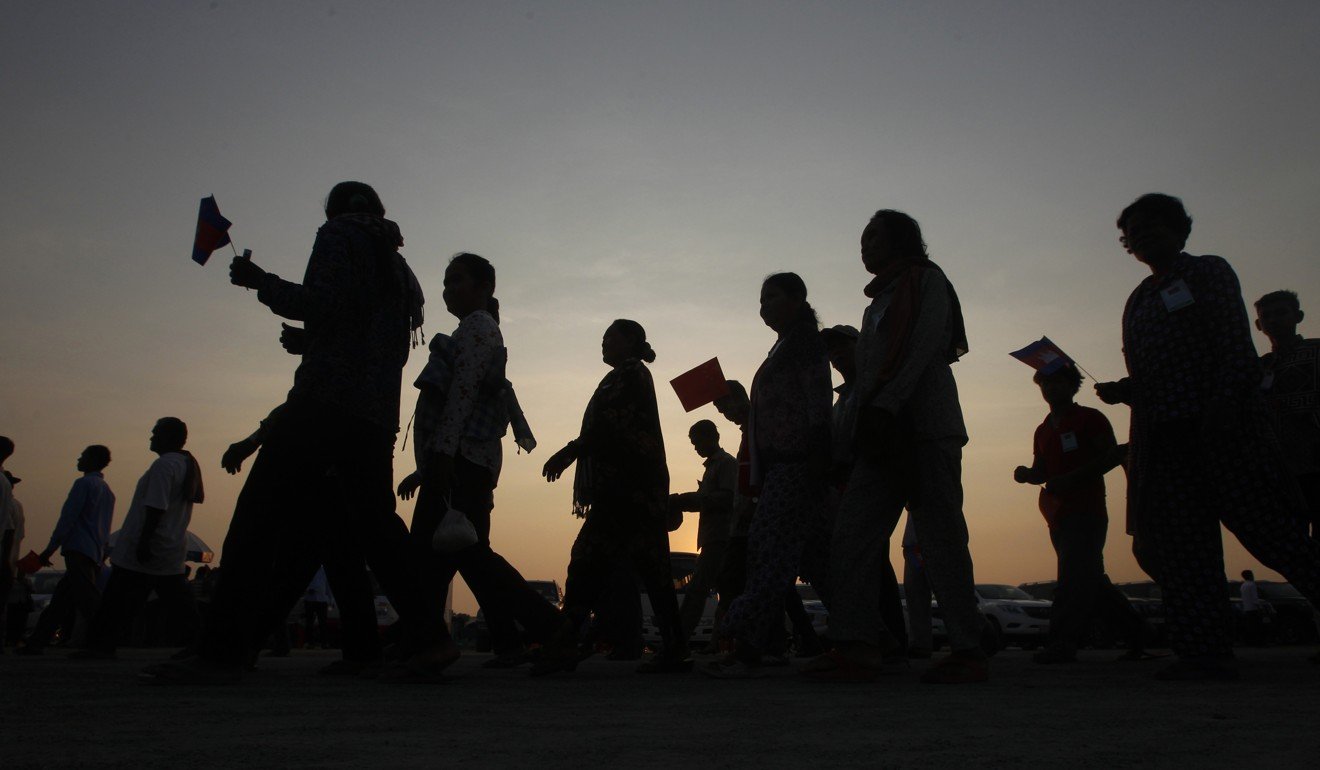
The Golden Lions Roundabout in Sihanoukville, Cambodia. Photo: Shutterstock
Chinese ‘old’ and ‘new’ keep the economy of Hun Sen’s Cambodia humming
But investment by Beijing has also entrenched the patronage system and given rise to anti-Chinese sentiment
Michiel Verver
Published: 2:00pm, 18 Jan, 2020
scmp
In considering the ways in which China’s new-found assertiveness affects Cambodian society, the perspective of Cambodia’s domestic private sector is intriguing for two reasons.
First, the private sector reveals an internal division between the politically connected and the bereft. An exclusive group of tycoons has been co-opted by top officials of the People’s Party. They receive lucrative benefits in business – including import monopolies, public contracts and land concessions – in return for loyalty and financial contributions to individual party officials and the ruling party as a whole. Meanwhile, the lion’s share of the private sector comprises of small and medium-sized enterprises (SMEs) – mostly family-owned and operated – that cope without political support and instead try to steer clear of lower-level rent-seeking officials.
Second, most entrepreneurs in Phnom Penh, tycoons and SME owners alike, are children or grandchildren of Chinese migrants who came to Cambodia, especially during the French colonial period and upon Mao’s takeover of China.

Chinese Ambassador to Cambodia Wang Wentian joins Cambodian Prime Minister Hun Sen at a groundbreaking ceremony for the Cambodia-China Friendship Tboung Khmum Hospital. Photo: Xinhua
Although the differences between the “old” and the “new” Chinese are vast – in terms of ethnic identification, language use and place of origin in China – there are also extensive kinship linkages among them. While many SME owners as well as tycoons in Phnom Penh are descendants of “old” Chinese immigrants, they engage with the “new” Chinese in different ways.
For SME owners in retail or services, “new” Chinese who work as managers and technicians in garment factories or construction companies in and around Phnom Penh are an increasingly important customer base. Moreover, many business owners in Phnom Penh have established trading connections with China since the 1990s, importing raw materials, machinery and consumer goods. Shared Chinese backgrounds and Mandarin are vehicles for creating trust in these business relations. Yet, the importance of shared identity among the “old” and “new” Chinese must not be overstated. Often, Cambodian SMEs manage to develop trading partnerships only if they have family connections in China. Vice versa, many “new” Chinese go it alone, importing and selling products or setting up services ventures in Phnom Penh, thus creating new competition for local businesses.
Recently, in what seemed an attempt to protect local SMEs against the “new” Chinese, the government signed a decree (later revoked) stating that 10 categories of jobs, including those of hairdresser, tuk-tuk driver and mechanic, were off limits for foreigners.
Cambodian entrepreneurs typically consider a localised Teochew identity – Teochew constitute the great majority of ethnic Chinese in Cambodia – more important than pan-Chinese affinity extended to “new” Chinese from Northeast Asia.
Since the demise of the Khmer Rouge regime in 1979, Cambodian Teochew developed their own regional connections – to China but especially also to fellow Teochew in Thailand and Singapore – and forged a tight-knit local network of traders and shopkeepers that now controls a wide range of sectors.
For tycoons operating within Phnom Penh’s elite, China is an export destination for Cambodian timber and cash crops, and “new” Chinese investments provide business opportunities in the form of construction contracts and joint ventures in real-estate development, industrial parks or the energy sector. Successful collaborations between local tycoons and “new” Chinese investors reveal a basic arrangement: the Chinese bring in investment and technical expertise, while the Cambodian partner provides the land, which foreigners are not allowed to own, and political “backing”. It is this arrangement that facilitates the establishment of production facilities and tourism ventures, and that has fuelled Phnom Penh’s luxury real-estate boom over the last decade.

Cambodians head to a groundbreaking ceremony in Kampong Speu province, south of Phnom Penh, for the country's first expressway, which is being funded by China. . Photo: AP
Thus the tycoons bridge regional Chinese business networks and Phnom Penh’s highly politicised business sphere, while pocketing large sums of money in the process (no small part of which allegedly flows back to their political patrons). Although investors from China give preference to dealing with local ethnic Chinese, again, the role of shared Chinese identity must not be overstated. Business deals between Cambodian Chinese tycoons and “new” Chinese investors typically spring from Cambodian People’s Party patronage – a number of tycoons have joined Hun Sen on his visits to China – more than shared ethnic background. Many tycoons cannot speak Chinese fluently, have no established network in China, and self-identify as Khmer. Besides, “new” Chinese investments often bypass the “old” Chinese. Infrastructural projects, including the construction of bridges, roads and hydropower dams, tend to be wholly financed and executed by Chinese state-owned enterprises, and over 40 Chinese firms currently hold so-called Economic Land Concessions – large land areas that they lease directly from the Cambodian state for periods of up to 99 years to develop resorts or plantations.
All in all, business exchanges among “old” and “new” Chinese often rely on family connections (among SMEs) or Cambodian People’s Party matchmaking (among the tycoons), more than shared Chinese ethnicity per se, and many local firms – big and small – neither benefit nor suffer from the “new” Chinese presence. That said, the impacts of “new” Chinese investments, businesses and migration on Cambodian society are vast. It can be argued that although “new” Chinese involvement does not fundamentally alter Cambodia’s politico-economic order, in two ways it has further perpetuated this order.
First, “new” Chinese involvement propels the revival of ethnic Chinese economic dominance, culture and language in Cambodia, which has occurred after the persecution and repression of Chinese under the Khmer Rouge (1975-79) and the Vietnamese-backed People’s Republic of Kampuchea (1979-89). By sending teachers and donating books and money, China supports Chinese schools in Cambodia. Chinese investors, white-collar workers and tourists are omnipresent, Chinese identity has come to stand for business success and prosperity, Phnom Penh’s otherwise-bustling markets come to a standstill during the Lunar New Year, and even Hun Sen has encouraged Cambodians to emulate Chinese-style wealth.
At the same time, anti-Chinese sentiments are on the rise due to the bad behaviour of some Chinese tourists and Chinese firms crowding out Cambodian ones. Of particular concern is the “takeover” of the coastal town of Sihanoukville, which is turning into a Chinese enclave comprising Chinese tourists and Chinese-owned tourism businesses such as casinos, restaurants and shops.
Second, “new” Chinese involvement in Cambodia has augmented the divide between the elite and the general population. By channelling aid and investment into Cambodia via Cambodian People’s Party-affiliated tycoons and in accordance with Hun Sen’s development agenda, Chinese private and public actors have provided Hun Sen the resources to oil the patronage system. Although a portion of Chinese investments and goods enter Cambodia through the effort of small-scale entrepreneurs – either “old” or “new” Chinese – without ties to the elite, these efforts are dwarfed by large-scale infrastructural and real-estate projects, mining concessions, and garment or tourism-sector investments. Phnom Penh’s business-state elite benefits from these investments by way of financial rewards, political consolidation and expanded business portfolios, whereas for most Cambodians these investments entail land evictions, the loss of rural livelihoods, or low-paid jobs in the garment or construction sectors. While the excesses of Hun Sen-style authoritarianism spread across Cambodia, partly facilitated by “new” Chinese involvement, it does not seem likely the government will reconsider its commitment to China any time soon. ■
Michiel Verver is an assistant professor at the Department of Organisation Sciences, VU Amsterdam, the Netherlands. This article is an extract from Trends in Southeast Asia: ‘Old and New Chinese Business in Cambodia’s Capital’, published by ISEAS – Yusof Ishak Institute

2 comments:
Don't worry: the destination to hell under Ah Lngi Lngeu Hun Sen's leadership will be reached soon !!
It is about time that Khmer people wake up and put up some fight - by peaceful and legal means - against this Yuon's puppet Hun Sen.
So far, Ah Roleuy Hun Sen has given in to all Yuon's demands in exchange for his power.
If Hun Sen can not be brought down by Cambodians, his children will bear all his sins and suffer hundred of years down the road for many generations.
Post a Comment